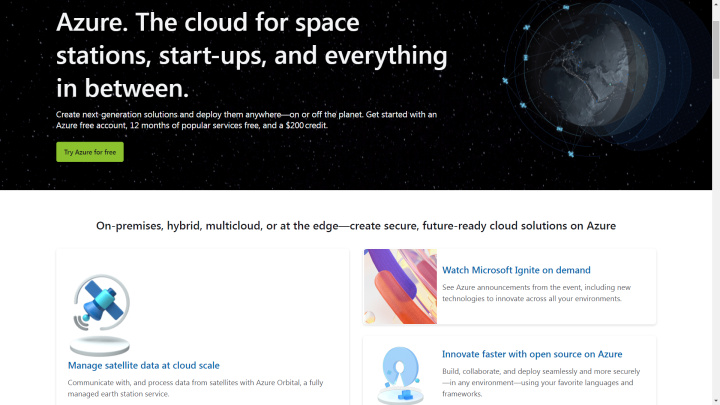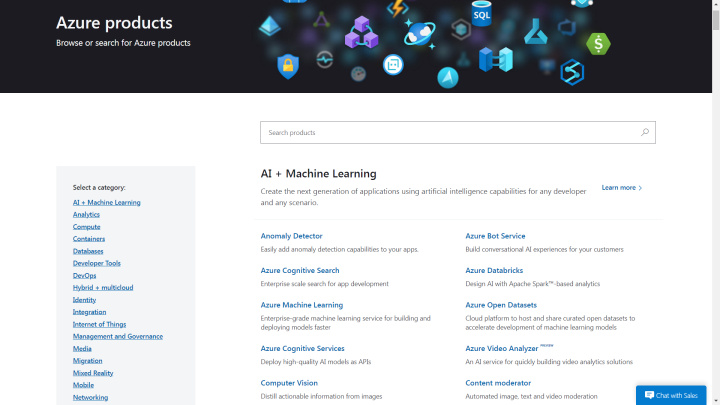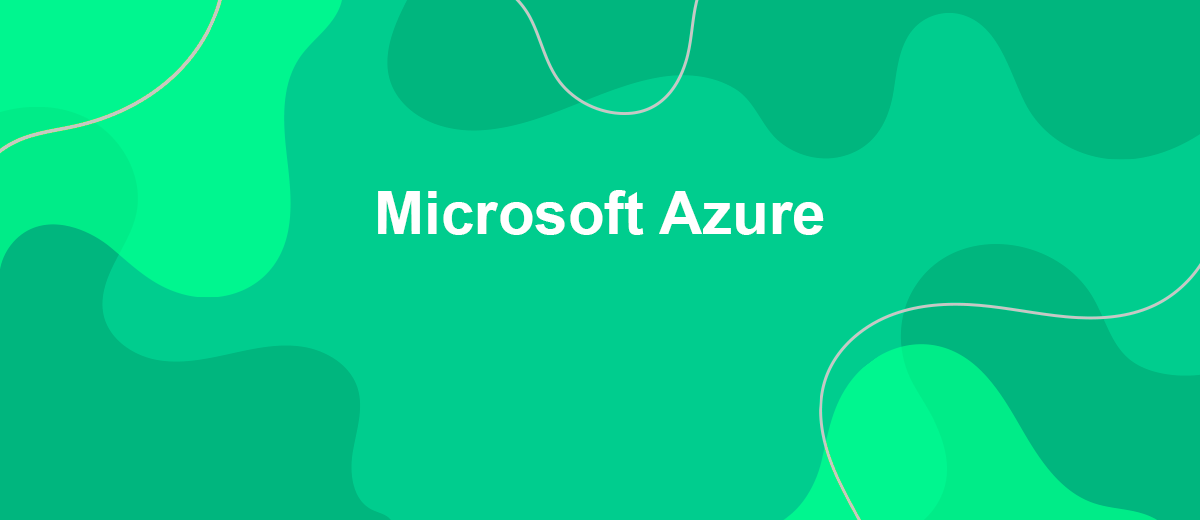Microsoft Azure - popular services and solutions for business
Content:
1 . An overview of the Microsoft Azure platform and its infrastructure
2 . History of origin and development of Microsoft Azure
3 . Microsoft Azure Core Services
4 . Microsoft Azure out-of-the-box solutions
5 . Conclusion
The Microsoft cloud platform has a significant 20% market share. And it is about it that we will tell you in our article. You will learn about what infrastructure and capabilities the Microsoft Azure platform provides, how it originated and developed, and what services are available to its users.
An overview of the Microsoft Azure platform and its infrastructure
The Microsoft Azure cloud platform includes a rich set of services in different formats: SaaS (software as a service), PaaS (platform as a service) and IaaS (infrastructure as a service). The capabilities of the software allow you to deploy additional resources to scale, perform synchronous data replication in an automatic mode, provide infrastructure fault tolerance, etc.
Having a REST API helps keep MA cloud services in sync with any external platform, device, and operating system. Using the Azure visual interface, users can develop their own services, configure and monitor infrastructure and operations, manage access rights, and process online payments. The platform includes sets of libraries for popular programming languages such as .NET, Java, PHP, or Python applications in containers or directly on Windows or Linux
The global market for cloud services in recent years has been growing at a truly explosive pace, for example, in 2020 it grew by almost a third and reached $40 billion. Top positions in this area are traditionally occupied by the products of three IT giants - Amazon Web Services, Google Cloud Services and Microsoft Azure.

Microsoft Azure products are available in more than 60 geographic regions and 140 countries around the world, and more than 160 data center (DPC) platforms are located in 15 countries.
History of origin and development of Microsoft Azure
2005-2011
The backstory of the platform began in 2005, when Microsoft bought Groove Networks, and Bill Gates appointed its founder, Ray Ozzy, as one of three CTOs. In turn, Ozzy persuaded the famous Dave Cutler (developer of Windows NT) to postpone his retirement, and together with another famous programmer Amitahb Srivastava, they began a new project - a cloud operating system.
The first announcement of this service was released in 2008, when it was codenamed Red Dog. In fact, at that time it was an extension for Windows NT, designed to work in the cloud. In 2009, Microsoft announced the Azure Relational SQL Database. On February 1, 2010, the official release of the cloud services platform, which was named Windows Azure, took place. It immediately began to position itself as a full-fledged alternative to the then already well-known Amazon EC2 and Google App Engine.
The first version of Azure provided a very limited set of services, namely a cloud computing service for developing and running ASP.NET web applications, Azure Blob data warehouse, Azure SQL cloud database, and Azure Service Bus. Back then, it was not exactly an enterprise-friendly cloud platform and was suitable only for a narrow audience of developers who created certain categories of web applications. In the same 2010, the platform was updated, after that it began to support .NET Framework 4, OS versioning and CDN, and was also supplemented by the Windows Azure Connect extension.
A year later, Microsoft again expanded its service with a number of innovations, including a traffic manager, a reporting engine for SQL Azure, and a high performance computing scheduler (HPC scheduler).
2012-2017
Meanwhile, the rise in popularity of open source applications and the development of Amazon EC2 have forced Microsoft to rethink its approach to the cloud. The corporation took into account two trends that were relevant at that time: increased user control of cloud applications through IaaS and the introduction of support for open source software for developers (especially based on Linux). In 2012, the platform received another set of updates, including Azure Websites, virtual machines for Windows and Linux, Python SDK, local backup, etc.


In 2014, Windows Azure was renamed Microsoft Azure, shortly thereafter, the Azure Resource Manager (ARM) was added to its product line, designed to manage application resources (deployment, organization, access control, etc.). That same year, Microsoft turned its attention to big data, following competitors like Amazon with its EMR and Google with BigQuery. As a result, it launched a range of services (Azure HDInsight, Azure Data Lake Store, and Azure Data Lake Analytics) that allowed it to fully realize the Big Data direction at the scale of the cloud platform. It also released a preview version of the Azure Machine Learning service.
In 2015, Microsoft acquired Revolution Analytics, which allowed it to add support for the R language, which is in demand in statistical computing and graphics, to its platform interface. Subsequently, the corporation began to develop the IoT direction. Azure has become one of the few public cloud platforms to provide end-to-end connectivity to a stack of devices powered by the Event Hub, IoT Hub, Stream Analytics, SQL Database, and Power BI.
Today, Microsoft is providing an IoT System Development (PaaS) option and a ready-to-use IoT SaaS module in Azure IoT Central, which was launched in 2018. At the same time, it released a cross-platform Linux distribution called Azure Cloud Switch, which is now called SONiC (Software for Open Networking in the Cloud) and is an open source network operating system based on Linux.
In 2016, the corporation introduced the Azure Kubernetes Service (AKS), designed to manage containerized applications based on the Kubernetes system. In addition, it has developed a number of other products in this area: Windows Containers, Virtual Kubelet, Service Mesh Interface, Open Application Model, and Distributed Application Runtime (DAPR). In 2017, new versions of the Microsoft Azure logo was created.
2018-2021
Starting in 2018, Microsoft begins to actively develop the AI&ML direction. Azure was one of the first cloud platforms to use graphic design to create and train machine learning models in Azure ML Studio. The corporation soon released Azure ML Services with even more capabilities, including advanced ML model training, support for NVIDIA GPUs, Intel FPGA, MLOps, and a drag-and-drop neural network builder.
At the same time, company developed the Azure IoT Edge service in collaboration with Intel, NVIDIA and Qualcomm. It offers users ample opportunities to integrate the Internet of Things (IoT) network, artificial intelligence (AI) technologies, and other Azure cloud services. The site allows you to create and train AI models in the cloud, offloading workloads to the cloud infrastructure, and then running them on-premises.
In 2019, the company introduced the Azure Front Door service, a cloud service for delivering content and protecting sites, applications and web interfaces from cyber threats. Starting in 2020, Microsoft began to develop two new trends - support for applications on the Kubernetes platform and multi-cloud infrastructure. Following them, the corporation launched an updated hybrid cloud strategy based on Kubernetes and introduced the new Azure Arc platform to the audience.

It gives users the ability to manage virtual and physical machines, as well as containerized applications on the Kubernetes system through a single dashboard. Azure Arc supports integration with a range of Azure cloud services within on-premises data centers. Going forward, Microsoft plans to transform Azure Arc into a universal computing fabric for multi-cloud and hybrid-cloud platforms.
Microsoft Azure Core Services
Microsoft's Azur Cloud Services Catalog includes over 200 services that are categorized into a number of thematic topics: analytics, security, databases, DevOps, computing, AI&ML, IoT, containers, mobile apps, storage, and more. The most famous and popular among them are:
- Virtual machines (VM). The system provides virtual machines for Windows and Linux operating systems suitable for running HPC software, SQL Server products, SAP, Oracle, etc. They have up to 416 vCPUs and 12 TB of memory, are capable of up to 3.7 million I / O operations per second, and support a 30 Gbps Ethernet connection. Using VM machines, users can flexibly manage workloads by migrating them to the Azure cloud infrastructure.
- App Service. Allows you to create web and mobile applications for any device or platform, and then deploy them in a highly scalable cloud infrastructure. It lets you run .NET, .NET Core, Node.js, Java, Python, or PHP applications in containers or directly on Windows or Linux. Supports continuous integration and delivery (CI / CD), virtual networking, running in an app service environment, third-party software integration via API such as Azure DevOps time tracking, and a range of security and data protection options.
- Azure Quantum. The service provides a set of cloud technologies for quantum and conventional computers, which include both ready-made solutions and functionality for developing software from scratch. It also has a unified development interface, optimization solutions, and quantum hardware. Integration with such quantum computing systems as Honeywell Quantum Solutions, IONQ, Quantum Circuits, 1Qloud, Microsoft QIO, Toshiba SBM is available.
- SQL Azure. Azure Cloud Relational SQL Database contains a number of AI-based automated features that provide high reliability and performance. Capable of updating, preparing and backing up data in auto mode. Provides fast serverless computing, automatically scales storage, providing up to 100 TB of space. Has built-in access control and multi-layered data protection.
- Azure Kubernetes (AKS). Enables you to develop and run Distributed Apps Runtime (Dapr)-enabled applications and microservices using serverless containers. Can be used to handle background tasks and events, APIs, different programming languages, SDKs, or platforms. Manual or automatic scaling is available based on a number of KEDA triggers (Kubernetes-based event-driven autoscaling), as well as flexible billing of the resources used.
- Azure Virtual Desktop. The service provides remote access to Windows 11 and Microsoft 365 desktops and applications through a highly scalable interface designed to work with multiple sessions (multi-session). Built-in security tools proactively protect against threats by responding instantly. Users can quickly and easily deploy and manage infrastructure, and scale resources. Cloud licenses can help you lower your virtual desktop (VDI) costs by paying only for the features you need.
- Azure Arc. The service provides centralized resource management in hybrid or multi-cloud environments. It can also be used to design and develop cloud applications, deploy data, application, and machine learning services on the infrastructure of your choice. Features to manage, control and protect Windows and Linux servers, SQL Server and Kubernetes clusters in data centers, multi-cloud and on-premises environments.
- Serverless computing. With this module, users can speed up and simplify the development of serverless applications. It allows you to leverage local resources to create software and automatically scale your cloud infrastructure. The service has a set of built-in tools for development, debugging, deployment, analytics and DevOps operations.
Microsoft Azure out-of-the-box solutions
- Application development. Software development and testing, DevOps, DevSecOps, e-commerce, game development, mobile apps, microservice apps, serverless computing, messaging services, app and data updates.
- Artificial intelligence. AI solutions for image analysis, speech understanding and data-driven prediction, data mining, confidential computing.
- Cloud migration and modernization. Azure Migration and Modernization Center, .NET application migration, development and testing, Linux integration, SAP integration, SQL Server / Windows Server / open source database migration.
- Data and analytics. Blockchain, business intelligence, scalable cloud analytics.
- Hybrid cloud and infrastructure. Data recovery, high performance computing (HPC), hybrid and multicloud solutions, quantum computing.
- Internet of Things. Azure IoT, Azure Managed Databases, Azure Industrial IoT, IoT Security.
- Security and administration. Cloud administration functions, data recovery, confidential computing, network security.
- Industry solutions. Financial services, government, healthcare, manufacturing, retail, energy, media and entertainment, aerospace.
Conclusion
Microsoft Azure has been among the most popular and largest cloud service platforms for several years, second only to Amazon Web Services. It provides users with more than 200 services and products in SaaS, PaaS and IaaS formats, which are available in 60 geographic regions and more than 140 countries around the world.

The most popular among them are the web and mobile application development service, virtual machines, virtual desktop, serverless computing service, as well as services Azure Quantum, SQL Azure, Azure Arc, Azure Kubernetes. Also Microsoft Azur offers a number of ready-made solutions for many industries, technologies and areas of activity.
Almost any person working with Internet services spends time and energy on many tasks of the same type. These include uploading leads from social networks to CRM, sending mailings to customers, copying orders from stores to spreadsheets, and so on.
So that you do not waste resources on this routine, we have created the ApiX-Drive connector. This simple tool allows you to automate a wide variety of workflows. You don't need to be a technician to work with it. It is enough to register on the connector website and configure the necessary automation scripts using prompts. Try it - it's impressively simple and fast process!

